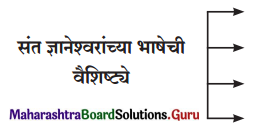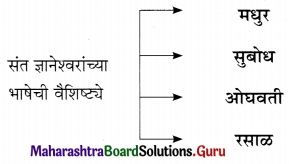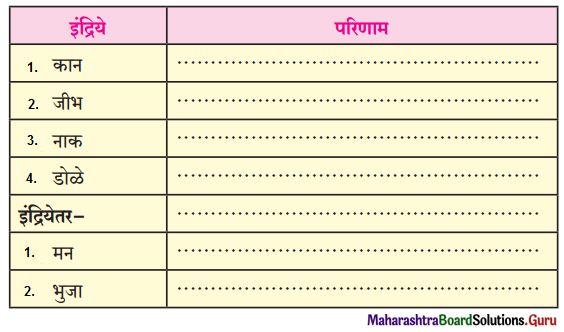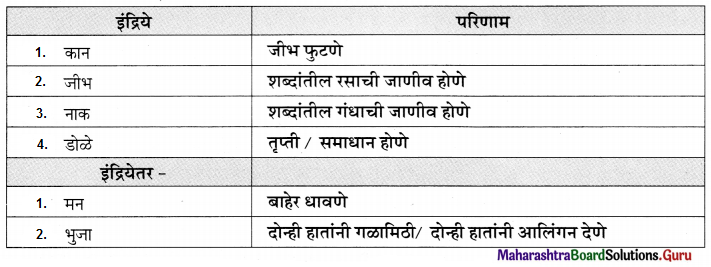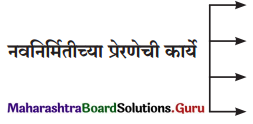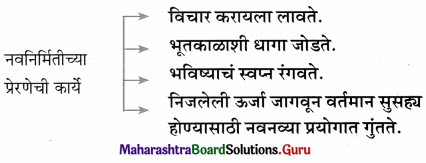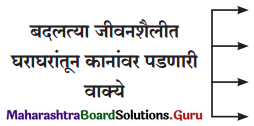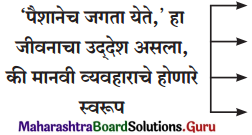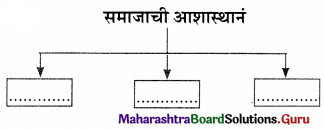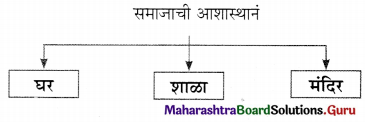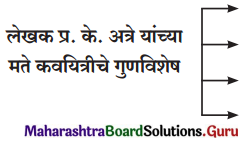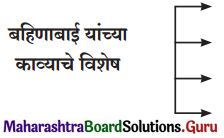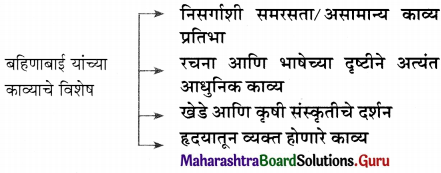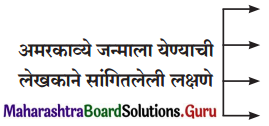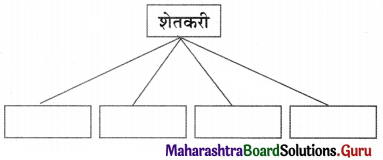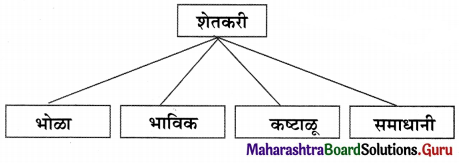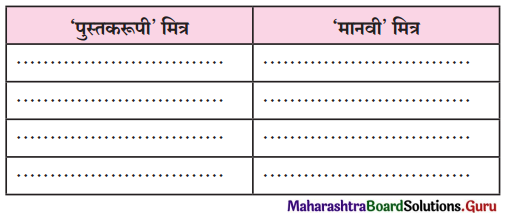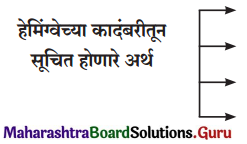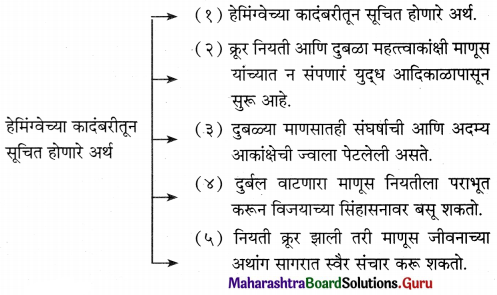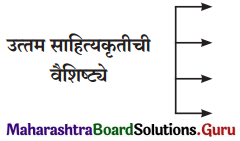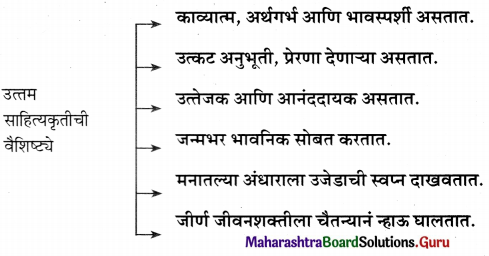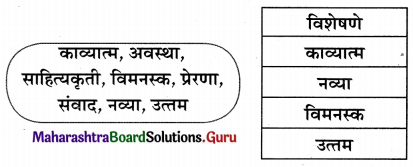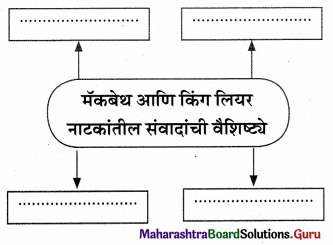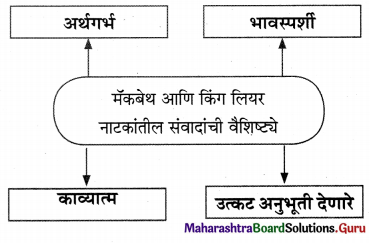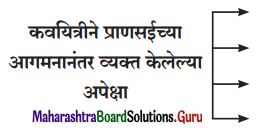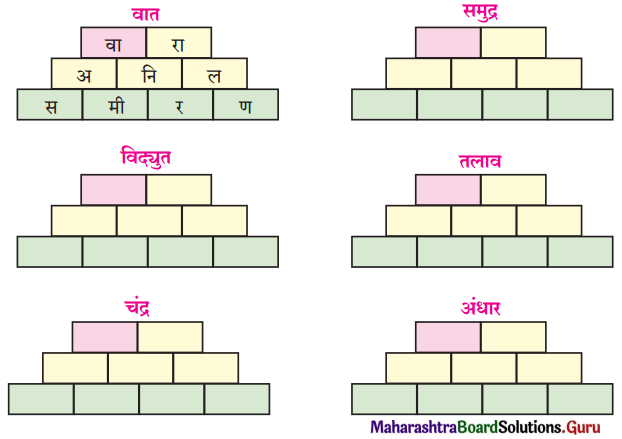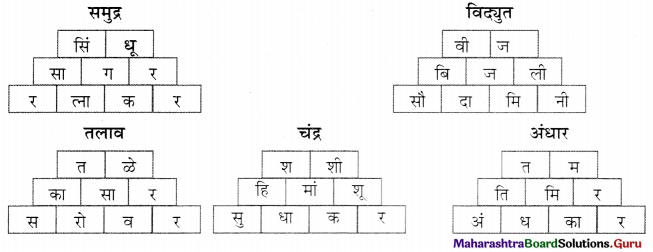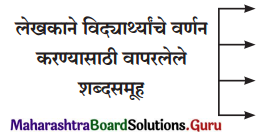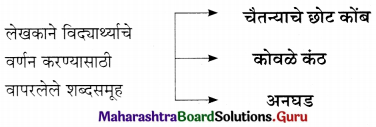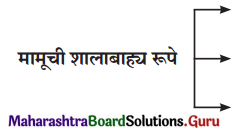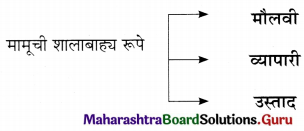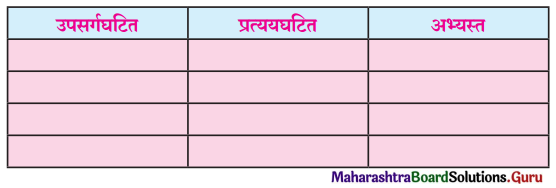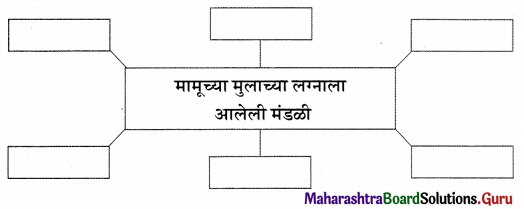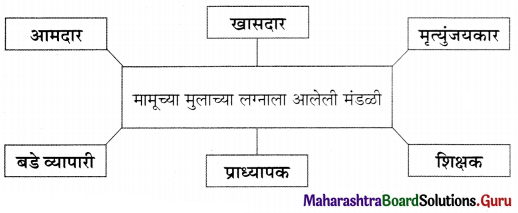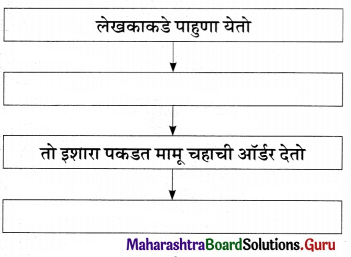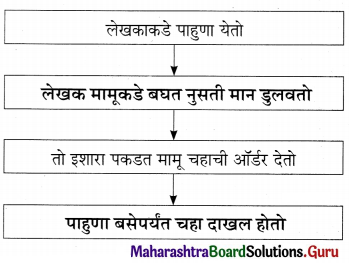Balbharti Maharashtra State Board Marathi Yuvakbharati 11th Digest Chapter 9 वहिनींचा ‘सुसाट’ सल्ला Notes, Textbook Exercise Important Questions and Answers.
11th Marathi Chapter 9 Exercise Question Answer Maharashtra Board
वहिनींचा ‘सुसाट’ सल्ला 11 वी मराठी स्वाध्याय प्रश्नांची उत्तरे
11th Marathi Digest Chapter 9 वहिनींचा ‘सुसाट’ सल्ला Textbook Questions and Answers
कृती
1. अ. कृती करा:
प्रश्न 1.
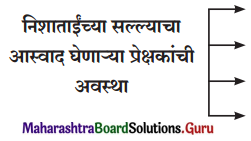
उत्तर :

आ. कारणे लिहा.
प्रश्न 1.
उषाताईंचा हा कार्यक्रम शेवटचा होता, कारण …………
उत्तर :
उषाताईंचा हा कार्यक्रम शेवटचा होता, कारण उषाताईंची वयाची अट्ठावन्न वर्षे पूर्ण होत होती. सरकारी नियमाप्रमाणे अठ्ठावन्न वर्षे वय हे सेवा निवृत्तीचे वय समजले जाते.

प्रश्न 2.
निशाने चेहऱ्यावर प्रौढपणा आणण्याचा प्रयत्न केला, कारण ………….
उत्तर :
निशाने चेहऱ्यावर प्रौढपणा आणण्याचा प्रयत्न केला, कारण दोघींच्या वयात पाच वर्षांचे अंतर होते. उषावहिनी या वयाने निशापेक्षा पाच वर्षांनी मोठ्या होत्या. त्यांचीच भूमिका त्यांच्याच नावाने करायची होती म्हणून निशाने चेहऱ्यावर प्रौढपणा आणण्याचा प्रयत्न केला.
प्रश्न 3.
महिला प्रेक्षकांत अपेक्षाभंगाची एक जोरकस लाट आली;कारण ………..
उत्तर :
महिला प्रेक्षकांत अपेक्षाभांगाची एक जोरकस लाट आली, कारण आज त्यांनी उलटाच प्रकार अनुभवला होता. मागील वीस वर्षांमधल्या कार्यक्रमात उषावहिनींच्या साडीवर चर्चा व्हायची आणि अगदी तश्शीच साडी खरेदी करायला बायकांच्या शोधयात्रा निघायच्या. पण आज मात्र अगदी साधी साडी त्यांनी परिधान केली होती ती साडी काठापदराची व मळखाऊ रंगाची होती म्हणून महिला प्रेक्षकांत अपेक्षाभंगाची एक जोरकस लाट पसरली.
प्रश्न 4.
मुंबईत आलेल्या पाहुण्यांची पंचाईत होते; कारण …………..
उत्तर :
मुंबईत आलेल्या पाहुण्यांची पंचाईत होते, कारण मुंबईतल्या बहुतेक स्त्रिया नोकरी करतात, त्यामुळे मुंबईत आलेल्या पाहुण्यांची पंचाइत होते.
इ. वैशिष्ट्येलिहा.
प्रश्न 1.
दूरदर्शनवरील ‘वहिनींचा सल्ला’ हा कार्यक्रम.
उत्तर :
मुंबईला दूरदर्शन सुरू झालं, त्यानंतर आजतागायत चालू असलेला एकमेव असा सर्वात लोकप्रिय कार्यक्रम होता. या कार्यक्रमात उषावहिनी महिलांना संसाराच्या बाबतीत ‘जोडा, जुळवा व जमवून घ्या’ असे सल्ले देत असत. थोडक्यात ‘वहिनींचा सल्ला’ या कार्यक्रमात उषावहिनी महिलांना सबुरीचा सल्ला देत असत. तसेच दुसऱ्याच्या दृष्टिकोनातून बघायला शिका अशा त-हेच्या सूचना त्या महिला प्रेक्षकवर्गाला देत असत.

प्रश्न 2.
शिवाजी मंदिर’ येथील ‘वहिनींचा सल्ला’ हा कार्यक्रम.
उत्तर :
‘बहिनींचा सल्ला’ हा लोकप्रिय कार्यक्रम होता या कार्यक्रमाने विशी गाठली होती. वयोमानाप्रमाणे निवृत्त व्हावे लागते याच नियमानुसार उपवहिनींना अट्ठावन्न वर्षे पूर्ण होत होती त्यामुळे या कार्यक्रमाला समाजातल्या अनेक मान्यवर व्यक्ती उपस्थित राहणार होत्या, तसेच उषावहिनींचा सत्कारही होणार होता. ह्या कार्यक्रमाची शेवटची दहा मिनिटं प्रेक्षकांना वहिनींशी फोनवरून थेट संपर्क साधता येणार होता. हा कार्यक्रम प्रथमच दूरदर्शन केंद्राच्या बाहेर होणार होता. तसेच शेवटचा म्हणूनच खास महत्त्वाचा होता.
ई. फरक स्पष्ट करून तक्ता पूर्ण करा.
प्रश्न 1.

उत्तर :
| उषावहिनींचा सल्ला |
निशावहिनींचा सल्ला |
| जोडा, जुळवा व समजून घ्या. |
थोडी भीड, थोडा संकोच, थोडी परंपरा गुंडाळून ठेवायची. |
| संसाराची दोन चाकं म्हणजे नवरा आणि बायको, एक चाक थोडसं कुचकामी असेल तर दुसऱ्या चाकाने आपल्यावर जास्त भार घ्यावा. |
संसाराच्या दोन्ही चाकांनी समसमान भार घ्यावा. |
| लोकांना वर्षानुवर्षे औषध म्हणून साखरेच्या गोळ्या दिल्या याचा अर्थ तडजोड व संयम यांचा सल्ला. |
लोकांना कडू क्विनाईचा डोस दिला म्हणजेच स्वत:चे अस्तित्व सिद्ध करण्याचा सल्ला. |
| भारतीय रूढी परंपरेला आव्हान न देणारे, शांत, सौम्य व्यक्तिमत्त्व व तसेच सल्ले, दुसऱ्याच्या दृष्टिकोनातून बघायला शिकायचा सल्ला. |
भारतीय रूडी-परंपरेला आव्हान देणारे सल्ले, स्वत:च्या मनाचा कौल घ्या, स्वतःला स्वत:च महत्त्व दिलं पाहिजे, आत्मसन्मान जपा असा सल्ला. |
2. पाठातील खालील वाक्याचा तुम्हांला समजलेला अर्थ स्पष्ट करा.
प्रश्न 1.
रंगीबेरंगी पोकळ बुडबुड्यांचा आजचा अंतिम दिवस.
उत्तर :
मागील वीस वर्षे उषावहिनींचा वहिनींचा सल्ला’ हा कार्यक्रम दूरदर्शनवरून प्रसारित होत होता. उषावहिनींच्या जोडा, जुळवा व जमवून घ्या या सल्ल्यामुळे हा कार्यक्रम त्यावेळी यशाच्या शिखरावर होता पण या सल्ल्याचा उपयोग खरोखरच कोणी संसारात किंवा जीवनात करून घेत का? असा प्रश्न उपस्थित रहात होता. प्रेक्षकवर्ग कार्यक्रमाला उत्स्फूर्तपणे दाद देत होता. सलग वीस वर्षे कार्यक्रम यशस्वी होत होता. वहिनी सगळ्यांना कार्यक्रमात सबुरीचा सल्ला देत असत पण खरोखरच्या जीवनात त्याचा अवलंब किती होत होता याचे उत्तर अनुत्तरीत होतं म्हणून रंगीबेरंगी पोकळ बुडबुड्यांचा आजचा अंतिम दिवस होता हे स्पष्ट होतं.
प्रश्न 2.
मी माणसांना दुःखप्रूफ किंवा दुःखमुक्त होण्यासाठी मदत करते.
उत्तर :
संसारामध्ये प्रत्येकाला अनेक समस्यांना सामोरे जावे लागते. काही जणांच्या आयुष्यात संकटांमागुन यातना किंवा दुःख सहन करावे लागते. यातून त्यांना बाहेर काढावे लागते. दुःखातून बाहेर काढण्यासाठी विविध मागांचा अवलंब करावा लागतो. सर्वसामान्य लोकांना दुःखातून बाहेर काढण्यासाठी अनेक सामाजिक संस्था तसेच सामाजिक कार्यकर्ते अहोरात्र झटत असतात. तसेच कार्य निशावहिनी करत आहेत. त्या कामगार क्षेत्रात काम करतात. समस्यांच्या मुळापर्यंत जातात व त्या समस्येतून लोकांना बाहेर काढण्याचा प्रयत्न करतात. तात्पर्य दुःखातून मुक्त होण्याचा योग्य तो मार्ग दाखवणारी व्यक्ती म्हणजेच खऱ्या अर्थाने समाजाची सेवा करणारी व्यक्ती होय, मात्र अगदी साधी साडी त्यांनी परिधान केली होती ती साडी काठापदराची व मळखाऊ रंगाची होती म्हणून महिला प्रेक्षकांत अपेक्षाभंगाची एक जोरकस लाट पसरली.

प्रश्न 3.
इतर घरांत नोकरीवाली बाई हे वॉटरप्रूफींग केलेलं असल्यामुळे आमच्या घरी पाहुण्यांचा जोरदार मारा!
उत्तर :
मुंबईसारख्या शहरात जर राहायचे असेल तर घरातील पुरुष व स्त्रिया यांनी नोकरी करणे आवश्यक असते नाहीतर खर्च भागवता भागवता नाकी नऊ येतात असा अनेकांचा अनुभव आहे. जर घरातील महिला नोकरी करीत असेल तर मुंबईत जे पाहुणे येतात ते त्यांच्या घरी जात नाहीत कारण त्यांची पंचाईत होते. त्यांची ऊठ-बस किंवा सरबराई करायला यजमानाच्या घरात हक्काची बाई नसते. याचाच अर्थ जर घर व्यवस्थित वॉटरप्रूफ केलं असेल तर पावसात गळायची भीती नसते. त्याचप्रमाणे घरातील महिला जर कामावर जात असेल तर पाहुणेरूपी पावसाची अजिबात भीती नसते.
प्रश्न 4.
‘कीड मुळापासून उपटून काढली पाहिजे, तरच झाड जगेल’
उत्तर :
कोणत्याही समस्येवर जर उपाय शोधायचा असेल तर त्या समस्येचा सखोल अभ्यास करून त्यावर उपाय शोधला पाहिजे तरच ती समस्या कायमची संपुष्टात येईल, ज्याप्रमाणे एखादया झाडाला जर कीड लागली आणि त्याकडे जर दुर्लक्ष केले गेले तर कीड ते झाड पूर्णपणे खाऊन टाकते. त्यामुळे जर कीड मुळापासून औषधमागांनी उपटून काढली तरच झाड जगेल. अन्यथा ते मरेल. त्याचप्रमाणे औषधरूपी सल्ल्याचा उपयोग जर संसारात केला किंवा रोजच्या जगण्यात केला तर त्याच त्याच समस्या पुन्हा उद्भवणार नाहीत व आयुष्य सुखासमाधानाने जगता येईल.
3. व्याकरण
अ. विशेष्य-विशेषणांच्या जोड्या पाठाधारे जुळवा.
प्रश्न 1.

उत्तर :
| विशेष्य |
विशेषणे |
| आठवणी |
कडूगोड |
| कळ |
जीवघेणी |
| वेळ |
फावला |
| पुळका |
पोकळ |
| असहकार |
अंजन |

आ. केवल वाक्ये, मिश्र वाक्ये आणि संयुक्त वाक्येयांची पाठातील प्रत्येकी दोन-दोन उदाहरणे शोधून लिहा.
प्रश्न 1.
केवल वाक्ये, मिश्र वाक्ये आणि संयुक्त वाक्येयांची पाठातील प्रत्येकी दोन-दोन उदाहरणे शोधून लिहा.
उत्तर :
1. केवल वाक्ये :
(अ) उषावहिनी पर्स घ्यायला आत गेल्या.
(ब) शिवाजी मंदिरच्या मागच्या पार्किंग स्पेसमध्ये गाडी थांबली.
2. मिन वाक्ये
(अ) जर या प्रश्नांची उत्तरं नकारार्थी असली तर हे अंजन वापरण्यावाचून तुम्हांला पर्याय नाही.
(ब) म्हणजे महाराष्ट्रात जेवढं जग सामावलेलं आहे त्यातल्या हजारो व्यक्तींना वहिनींनी सल्ले दिले होते.
3. संयुक्त वाक्ये:
(अ) पाहुण्यांचा पाऊस पडायला लागला, की डोक्यावर उलटी छत्री धरायची.
(ब) माझ्या पावसासाठी तुम्हीच रेनकोट पुरवू शकाल, अशी माझी खात्री आहे. कारण माझ्याकडे पाऊस पडतो तो पाहुण्यांचा.
इ. खालील विरामचिन्हांची नावे कंसातील यादीतून शोधून लिहा.
(अपूर्णविराम, संयोगचिन्ह, अर्धविराम, अपसारणचिन्ह, लोपचिन्ह)
प्रश्न 1.
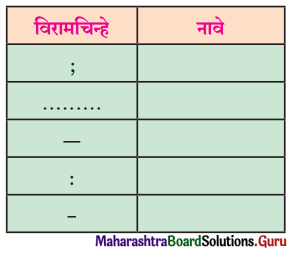
उत्तर :
| विरामचिन्हे |
नावे |
| ; |
अर्धविराम |
| ………… |
लोपचिन्ह |
| — |
अपसरण चिन्ह |
| : |
अपूर्ण विराम |
| – |
संयोगचिन्ह |

ई. खालील वाक्प्रचारांचा अर्थ लिहून वाक्यांत उपयोग करा.
प्रश्न 1.
अ. काजवे चमकणे – ………………….
आ. डोळे लकाकणे – ………………..
इ. कायापालट होणे – ………………..
ई. कडेलोट होणे – …………………..
उत्तर :
अ. काजवे चमकणे- अंधारी येणे किंवा अतिशय घाबरणे.
वाक्य : अचानकपणे दुचाकी घसरून झालेल्या अपघातामुळे माझ्या डोळ्यांसमोर काजवे चमकले.
आ. डोळे लकाकणे – आशेचा किरण दिसणे,
वाक्य : अर्जुनाची भूमिका करणारा अभिनेता मिळाल्यावर दिग्दर्शकाचे डोळे लकाकले.
इ. कायापालट होणे – अनपेक्षित बदल होणे.
वाक्य: बऱ्याच वर्षांनतर गावी गेल्यावर गावचा कायापालट झालेला मला दिसला.
ई. कडेलोट होणे – गोंधळाची परिस्थिती निर्माण होणे.
वाक्य : काहीही चूक नसताना पोलिस चौकशीला येत आहेत हे समजल्यावर श्यामची अवस्था कडेलोट झाल्यासारखी झाली.
उ. खालील शब्दांचे वर्गीकरण करा.
प्रश्न 1.

उत्तर :

4. स्वमत
प्रश्न अ.
वहिनींचा सल्ला ‘सुसाट’ वाटण्याची तुम्हांला समजलेली कारणे लिहा.
उत्तर :
कथेचा अभ्यास केला असता वहिनींचा सल्ला सुसाट आहे. उघावहिनी निशावहिनी यांच्या सल्ल्यात जमीन अस्मानाचा फरक आहे. उषावहिनी या ‘जोडा’, ‘जुळवा’ व ‘जमवून घ्या’ असा सल्ला देत असत. पण निशावहिनींचे सल्ले मात्र अगदी त्यांच्या विरुद्ध असल्याचे जाणवते. भीड, संकोच व परंपरा गुंडाळून ठेवायच्या, पाहुण्यांना येणारा प्रेमाचा पोकळ पुळका ओळखायला शिकायचा. त्याचप्रमाणे नोकरी करणाऱ्या स्त्रीला ‘जोडा, जुळवा व जमवून घ्या’ यांऐवजी ‘असहकार’ पुकारायला सांगणे व त्याच मार्गाने म्हणजे जशास तसे उत्तर देऊन वठणीवर आणायचे असे सल्ले वहिनींनी दिले.
एका बाजूला उषावहिनींचा सामोपचाराचा सल्ला व दुसऱ्या बाजूला निशावहिनींचा अगदी त्यांच्या विरोधातला म्हणजे जशास तसे उत्तर देण्याचा सल्ला, कीड मुळापासून उपटून काढली पाहिजे, तरच झाड जगेल असा साधारणपणे समाजाच्या रूढी परंपरेशी विसंगत असा निर्णय घेण्याची हिंमत म्हणूनच वहिनींचा सल्ला आम्हांला ‘सुसाट’ वाटतो.

प्रश्न आ.
‘पाहुण्यांचा पाऊस यासंबंधी कथेत आलेला विनोद तुम्हाला आवडला का, ते सकारण स्पष्ट करा.
उत्तर :
निलंजना बॅनर्जी यांनी पावसाप्रमाणे येणाऱ्या पाहुण्याविषयीच्या समस्येचा प्रश्न विचारला पण तो त्यांनी सांगताना किंवा मांडताना वेगळ्या पद्धतीने मांडला. त्यामुळे येथे विनोदाची निर्मिती झालेली दिसून येते. निलंजना बॅनर्जी या गृहिणी आहेत. त्या एका सेवाभावी संस्थेत घरची जबाबदारी सांभाळून काम करतात. त्यांची कुटुंबियांच्या संदर्भात कोणतीच समस्या नव्हती, त्या गृहिणी असल्यामुळे त्यांच्याकडे सतत पाहुण्यांचा राबता असायचा, पाऊस जसा धो धो कोसळतो व तो अनियमित असतो त्याचप्रमाणे त्यांच्याकडे भरपूर पाहुणे यायचे. हे सांगताना त्यांनी पाहण्यासाठी पावसाची उपमा वापरली.
त्यावरून त्यांच्याकडे येणाऱ्या पाहुण्यांचे प्रमाण जास्त असल्याचे लक्षात येते म्हणून त्यांनी अशी समस्या मांडली. त्यावर निशा बहिनींनी उत्तर दिले, माझा वॉटरप्रूफिंगशी काहीही संबंध नाही यामुळे प्रश्नाचा अर्थ समजण्यात किंवा समजावण्यात थोडीशी गफलत झालेली दिसून येते. त्यामुळे विनोदाची निर्मिती होते म्हणजेच शब्द फिरवल्यानंतर हलका फुलका विनोद निर्माण होतो. त्यामुळे मला हा विनोद आवडला.
प्रश्न इ.
सल्ला मागण्यासाठी मांडलेल्या समस्यांविषयी तुमचे मत लिहा.
उत्तर :
प्रत्येकाला आयुष्यात अनेक प्रकारच्या समस्या असतात त्यावर जर त्यांना उपाय सापडला नाही तर मात्र इतरत्र सल्ले मागितले जातात. कथेमध्ये ज्या काही समस्या मांडल्या आहेत. त्या सर्वसामान्य गृहिणींच्या आहेत. बऱ्याच घरात नवरा व बायको दोघेही नोकरी करतात पण घरातल्या कामात मात्र बराचसा पुरुषवर्ग हात आखडता घेत असतो. त्यामुळे बऱ्याच नोकरदारांच्या घरी घरातल्या कामांसंबंधी समस्या निर्माण होते. दुसरी समस्या म्हणजे मुंबईत येणाऱ्या पाहुण्यांची समस्या. शक्यतो ज्या घरातील स्त्री नोकरी करत नाही त्याच घरात पाहुण्यांचा राबता असतो.
काही वेळा पाहुण्यांना प्रेमाचा पोकळ पुळका येतो. तसेच घराघरात सासू आणि सुनेची एकत्र नांदण्याची समस्या, अनेक महिलांना पुरुष सहकाऱ्यांचे, हाताखाली काम करणाऱ्या पुरुषांचे कामावर येणारे धक्कादायक अनुभव आहेत, मुलींची रस्त्यावरील छेडाछाड समस्या खरोखरच समाजाला एका वेगळ्याच मार्गावर नेत आहेत. त्यामुळे या सर्व समस्या गंभीर स्वरूपाच्या आहेत.
मुलींची रस्त्यावर होणारी छेडछाड यामुळे तिला बाहेर पडणे कठीण होते. कार्यालयात आलेल्या अनेक वाईट अनुभवांमुळे ती सुरक्षित नसते. दारूच्या व्यसनामुळे संसाराची झालेली वाताहात, दारूच्या आहारी गेलेल्या नवऱ्याबरोबर सतत होणारी भांडणे, त्यांचे कुटुंबावर होणारे परिणाम, खालावलेली आर्थिक परिस्थिती त्यामुळे या समस्या योग्य आहेत. असे माझे मत आहे.

प्रश्न ई.
खऱ्या उषावहिनींनी आपल्या बहिणीच्या कामाला दिलेल्या पसंतीविषयी’ तुमच्या प्रतिक्रिया लिहा.
उत्तर :
उषावहिनी व निशावहिनी दोघीही सारख्या बहिणी होत्या. पण त्या दोघींच्या स्वभावात मात्र खूपच फरक होता. उषावहिनींचा स्वभाव जोडा, जुळवून घ्या असा होता म्हणजेच सबुरीच्या सल्ल्याप्रमाणे होता. पण अगदी त्यांच्या उलट निशावहिनींचा स्वभाव होता. समाजात जीवन जगत असताना सरळ मार्गी जाणाऱ्या माणसाशी सरळ मार्गाने वागावे पण जर तो वाकड्या मार्गाचा अवलंब करीत असेल तर आपणसुद्धा तशाच मार्गाचा अवलंब केला तर मात्र आपण यशस्वी होतो.
असे निशाबहिनींच्या स्वभावाचे पैलू होते. त्यामुळे शेवटच्या ‘वहिनींचा सल्ला’ या कार्यक्रमात निशावहिनी यांनी आपला ठसा उमटवला. उषावहिनींनी प्रतिक्रिया देताना असे म्हटले की “मी लोकांना वर्षानुवर्षे औषध म्हणून साखरेच्या गोळ्या देत आले. तू मात्र आज लोकांना कडू क्विनाईनचा डोस देण्याचं धाडस केलंस.” माझ्या मते दिलेली पसंती ही योग्य आहे कारण सध्याच्या काळात जर असे वागले तरच निभाव लागणे शक्य आहे. मग ती समस्या घरात असो किंवा घराच्या बाहेर असो मुंबईसारख्या शहरात तर असे वागणे हीच काळाची गरज आहे. त्यामुळे निशावहिनींनी महिलांना विविध समस्यांबाबत दिलेला सल्ला मला योग्य वाटतो.
5. अभिव्यक्ती :
प्रश्न अ.
वहिनींचा ‘सुसाट ‘ सल्ला ही कथा तुम्हांला का आवडते, ते लिहा.
उत्तर :
उत्तरासाठी कृती : 3 मधील स्वमत पहा.
प्रश्न आ.
‘स्त्रीने स्वतःच्या आत्मसन्मानाला जपले पाहिजे,’ याविषयीचे तुमचे विचार लिहा.
उत्तर :
सध्याच्या काळात स्त्रिया या पुरुषांच्या बरोबरीने प्रत्येक क्षेत्रात खांदयाला खांदा लावून काम करीत असतात. त्या कुठेही कमी पडत नाहीत. क्तिक पातळीवरसुद्धा स्त्रियांनी आपले अस्तित्व विविध क्षेत्रांत सिद्ध करून दाखवले आहे. अजूनही काही ठिकाणी तिचे अस्तित्व नाकारले जाते किंवा तिने केलेल्या कामाला फारसे महत्त्व दिले जात नाही. पण माझ्या मते स्त्रीला समाजात मानाचे स्थान मिळायला हवे तसेच प्रत्येक ठिकाणी समान हक्क मिळायला हवा.
जर तिने स्वतःला सिद्ध करून दाखवले तर तिचे महत्त्व समाजाला पटेल, खासकरून ज्या ठिकाणी पितृसत्ताक पुरुषप्रधान संस्कृती पद्धत आहे त्या ठिकाणी स्त्रियांचा आत्मसन्मानाचा प्रश्न निर्माण होताना आपणास दिसतो. प्राचीन काळापासून ते आत्तापर्यंतच्या विविध दाखल्यांतून आपणास हे समजते. संतांनी स्त्रियांच्या आत्मसन्मानाबद्दल प्रथम वाचा फोडली. संत जनाबाईना स्वतःचे अस्तित्व सिद्ध करण्यासाठी झटावे लागले. पण संत नामदेवांनी तिला ते प्राप्त करून दिले.
‘नामयाची दासी’ म्हणविण्यात जीवनाचे सार्थक मानणाऱ्या संत जनाबाईचे सुमारे 350 अभंग आज उपलब्ध आहेत. सावित्रीबाई फुले, बहिणाबाई चौधरी यांनी ही परंपरा पुढे चालू ठेवली. त्यानंतर विविध प्रकारच्या लिखाणातून हे वारंवार सिद्ध झाले आहे. आज अनेक सामाजिक क्षेत्रात, वैयक्तिक क्षेत्रात स्त्रिया मानाच्या पदावर आहेत. भारतासारख्या विशाल देशात तर पंतप्रधानपदी (स्व. इंदिरा गांधी) व राष्ट्रपतीपदी (प्रतिभाताई पाटिल) देखील महिलांनी आपल्या कार्याचा ठसा उमटवला आहे.
याचाच अर्थ स्त्रियांनी आपल्या मनातील न्यूनगंडाची भावना जर दूर सारली तर तिला समाजात मानाचे स्थान मिळेल. याचाच अर्थ स्त्रियांनी परंपरेच्या जोखडात न राहता गृहिणींनीसुद्धा आपला आत्मसन्मान जपला पाहिजे तसेच तिच्या घरातील आणि समाजातील लोकांनीसुद्धा तिचा आदर करणे/ जपणे फार महत्त्वाचे आहे.
प्रकल्प.
प्रश्न 1.
प्रसारमाध्यमांतून सतत दाखवल्या जाणाऱ्या जाहिराती व मालिका यांविषयी समवयस्कांशी चर्चा करा व त्यासंबंधी अहवाल तयार करा.
11th Marathi Book Answers Chapter 9 वहिनींचा ‘सुसाट’ सल्ला Additional Important Questions and Answers
कारणे लिहा.
प्रश्न 1.
सभागृहात टाचणी पडेल अशी शांतता पसरली, कारण ……
उत्तरः
सभागृहात टाचणी पडेल अशी शांतता पसरली, कारण सौम्य व्यक्तिमत्त्व आणि समतोल सल्ले देणाऱ्या उषाबहिनींच्या स्वभावात अचानक बदल झाला होता. त्यांचे स्वत:च्या मनाचा कौल घ्या, स्वत:ला स्वत:च महत्त्व दया, आत्मसन्मान जपा, असे भारतीय रूढी-परंपरेला आव्हान देणारे सडेतोड विचार ऐकन सभागृहात टाचणी पडेल अशी शांतता पसरली.

प्रश्न 2.
खालील वाक्प्रचारांचा अर्थ लिहून वाक्यांत उपयोग करा.
उत्तर :
1. किंकाळी फोडणे – अतिशय जोराने ओरडणे.
वाक्य : आपल्या मुलाचा आपल्या डोळ्यादेखत झालेला अपघात पाहून त्या मातेने किंकाळी फोडली.
2. प्रयत्नांची पराकाष्ठा करणे – खूप प्रयत्न करणे.
वाक्य : छत्रपती शिवाजी महाराजांबरोबर स्वराज्य निर्माण करण्यासाठी अनेक मावळ्यांनी प्रयत्नांची पराकाष्ठा केली.
3. गैरसमज होणे – चुकीचा समज होणे.
वाक्य : राम हा स्वार्थी आहे असा श्यामचा गैरसमज झाला.
4. आस्वाद घेणे- आनंद घेणे.
वाक्य : बऱ्याच प्रतिक्षेनंतर पडलेल्या पावसात मुलांनी कांदाभजीचा आस्वाद घेतला.
5. आसनाला खिळणे – मग्न होणे.
वाक्य : एका लग्नाची पुढची गोष्ट नाटकाचा प्रयोग पाहताना प्रेक्षकवर्ग आसनाला खिळला होता.
6. मान डोलावणे- होकार दाखविणे.
वाक्य : रमेशच्या लग्नाला पालीला जायचे आहे असे कबीरने सांगितल्यानंतर मी मान डोलावली.
शब्दसंपत्ती :
प्रश्न 1.
खालील वाक्यांचा अभ्यास करा. ‘कर’ या शब्दाची योग्य अर्थच्छटा कंसातील पर्यायातून निवडा. ती वाक्यांसमोर कंसांत लिहा.
टॅक्स. कृत्य, हात करणे (क्रयापद)
उत्तर :
अ. दाम करी काम वेड्या – (करणे) (क्रियापद)
आ. कर भरणे प्रत्येक नागरिकाचे कर्तव्य आहे – (टॅक्स)
इ. कर हा करी धरिला शुभांगी – हात
ई. कर नाही त्याला डर कशाला ? – कृत्या
आकलन कृती :
खालील पठित गदय उताऱ्याच्या आधारे सूचनेनुसार कृती करा.
प्रश्न 1.
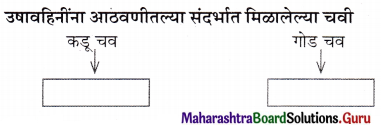
उत्तर :

‘वहिनींचा सल्ला’ या कार्यक्रमाची शिवाजी मंदिरातील वर्षसंख्या व उषावहिनींचे त्यावेळेचे वय.
प्रश्न 1.
1. वर्षसंख्या – [ ]
2. उषावहिनींचे त्यावेळेचे वय – [ ]
उत्तर :
1. वर्षसंख्या – 20
2. उषावहिनींचे त्यावेळेचे वय – 58

चौकट पूर्ण करा.
प्रश्न 1.
उषावहिनींच्या शेवटच्या कार्यक्रमाचे वैशिष्टय – [ ]
उत्तर :
उषावहिर्नीच्या शेवटच्या कार्यक्रमाचे वैशिष्ट्य – हा कार्यक्रम स्टुडिओमधून काढून शिवाजी मंदिरमध्ये ठेवला होता. त्यासाठी समाजातल्या मान्यवर व्यक्ती निमंत्रित केल्या होत्या. उघावहिनींचा सत्कार होणार होता.
प्रश्न 2.
मागील वीस वर्षांत उषावहिनींनी कार्यक्रमादरम्यान सुखी संसारासाठी वापरलेली आयुधे.
1. ……… 2. ……… 3. ……… 4. ………
उत्तर :
1. हंडाभर फेविकॉल.
2. दोन-चार मैल लांबीच्या चिकटपटट्या.
3. शंभर एक किलो डिंक.
4. पाच सात बरण्या च्युइंग गम
प्रश्न 3.
‘आला प्रॉब्लेम समोर की, लाव त्याला चिकटपट्टा
परिणाम – …………….
उत्तर:
कृती – ‘आला प्रॉब्लेम समोर की, लाव त्याला चिकटपट्टी
परिणाम – कार्यक्रम यशस्वी
प्रश्न 4.

उत्तर:

प्रश्न 5.
मुंबईला दूरदर्शन सुरू झाल्यानंतरचा एकमेव असा सर्वात लोकप्रिय कार्यक्रम – [ ]
उत्तर :
बहिनींचा सल्ला
उपयोजित कृती
प्रश्न 6.
गटात न बसणारा शब्द ओळखा.
दूरदर्शन, गाडी, कार्यक्रम, स्टुडिओ.
उत्तर :
गाडी.

प्रश्न 7.
घटनाक्रम योग्य क्रमानुसार लावा.
समाजातल्या अनेक मान्यवर व्यक्ती आज निमंत्रित होत्या.
उषावहिनींनी एकशेबावन्नाव्यांदा आरशात पाहिलं.
उषावहिनींनी एकशेचौपन्नाव्यांदा घड्याळात पाहिलं.
चार पावलं भराभरा मागे जाऊन, चार पावलं भराभरा पुढे येऊन स्वतःला पाहिलं.
उत्तर :
उषावहिनींनी एकशेबावन्नाव्यांदा आरशात पाहिलं.
चार पावलं भराभरा मागे जाऊन, चार पावलं भराभरा पढे येऊन स्वत:ला पाहिलं.
समाजातल्या अनेक मान्यवर व्यक्ती आज निमंत्रित होत्या.
उषावहिनींनी एकशेचौपन्नाव्यांदा घड्याळात पाहिलं.
प्रश्न 8.
योग्य विरामचिन्हांचा पर्याय ओळखा.
वहिनींच्या सल्ल्याचा शेवटचा कार्यक्रम.
पर्याय :
(अ) एकेरी अवतरणचिन्ह, पूर्णविराम
(ब) स्वल्पविराम, पूर्णविराम
(क) स्वल्पविराम, उदगारवाचक चिन्ह
(ड) पूर्णविराम, अपसारण चिन्ह.
उत्तर :
एकेरी अवतरणचिन्ह, पूर्णविराम, विरामचिन्हे घालून वाक्य – ‘वहिनींच्या सल्ल्या’चा शेवटचा कार्यक्रम.
आकलन कृती :
खालील पठित गदय उताऱ्याच्या आधारे सूचनेनुसार कृती करा.
प्रश्न 1.

उत्तर:

खालील घटनेचा परिणाम लिहा.
- घटन – वीस वर्षामधल्या प्रत्येक कार्यक्रमानंतर उपावहिनींच्या साडीवर चर्चा व्हायची.
- परिणाम – अगदी तश्शीच साडी खरेदी करायला बायकांच्या शोधयात्रा निघायच्या.

सूचननुसार कृता करा.
प्रश्न 1.
‘निशाने चेहऱ्यावर प्रौढपणा’ हे उत्तर येईल असा प्रश्न तयार करा.
उत्तर :
निशाने चेहऱ्यावर काय आणण्याचा प्रयत्न केला?
प्रश्न 2.
‘वहिनींचा सल्ला हा कार्यक्रम दरवेळी आवर्जून पाहिला जायचा कारण …. [ ]
उत्तर :
‘वहिनींचा सल्ला हा कार्यक्रम दरवेळी आवर्जून पाहिला जायचा कारण – उषावहिनींनी नेसलेली साडी
खालील शब्दसमूहासाठी उताऱ्यात योजलेले शब्द.
प्रश्न 1.
नाट्यप्रयोग सादर करतात ते ठिकाण – [ ]
उत्तर :
नाट्यप्रयोग सादर करतात ते ठिकाण – नाट्यगृह
प्रश्न 2.
कार्यक्रमाचं निवेदन करणारा – [ ]
उत्तर :
कार्यक्रमाचं निवेदन करणारा – निवेदक
उपयोजित कृती
कोण ते लिहा.
प्रश्न 1.
उषावहिनींच्या भूमिकेत स्वतःला सराईतपणे झोकून देणारी व्यक्ती – [ ]
उत्तर :
उषावहिनींच्या भूमिकेत स्वतःला सराईतपणे झोकून देणारी व्यक्ती – निशावहिनी

प्रश्न 2.
अपेक्षाभंगाची लाट पसरवणारा प्रेक्षकवर्ग – [ ]
उत्तर :
अपेक्षाभंगाची लाट पसरवणारा प्रेक्षकवर्ग – महिला
प्रश्न 3.
गटात न बसणारा शब्द ओळखा.
उत्तर :
1. प्रौढ, वयस्कर, थोराड, तारुण्य – तारुण्य
2. लोकप्रिय, नावाजलेला, प्रसिद्ध, चर्चेतला – चर्चेतला
प्रश्न 4.
खालील शब्दांसाठी योग्य समानार्थी शब्दांचा पर्याय निवडा.
उत्तर :
प्रयोग – खेळ, नाटय, लोकरंग, नाट्यरंग –
खेळ सराईत – हुषार, तरबेज, अडाणी, डळमळीत – तरबेज
चूक की बरोबर ते लिहा.
प्रश्न 1.
- निशावहिनींची उषावहिनींच्या सहकाऱ्यांशी चांगली ओळख नव्हती.
- ‘वहिनींचा सल्ला’ या कार्यक्रमाचा शिवाजी मंदिरातील प्रयोग हा पहिलाच प्रयोग होता.
- उषावहिनींचा ‘वहिनींचा सल्ला’ हा कार्यक्रम आवर्जून पाहिला जायचा याचे प्रमुख कारण म्हणजे उपावहिनींनी नेसलेली साडी होय,
उत्तर :
- चूक
- चूक
- बरोबर

स्वमतः
प्रश्न 1.
वहिनींचा ‘सुसाट’ सल्ला ही कथा तुम्हाला का आवडते ते लिहा.
उत्तर :
वहिनींचा ‘सुसाट’ सल्ला ही कथा ‘एका फांदीवरची पाखरं’ या पुस्तकातून घेतली आहे. ही कथा शोभा बोंद्रे यांनी लिहिली आहे. ही कथा विनोदी अंगाने लिहिलेली एक हलकी-फुलकी कथा आहे. काही उलट-सुलट घटना, माणसाच्या वागण्यातील विरोधाभास आणि गमतीशीर व्यक्तिचित्रणे यांमुळे कथा गंमतदार झाली आहे.
वहिनींचा ‘सुसाट’ सल्ला ही कथा महिला वर्गाच्या विविध प्रश्नांवर पैलू टाकणारी कथा आहे. उषावहिनी ‘वहिनींचा सल्ला’ हा कार्यक्रम मागील वीस वर्षांपासून सादर करीत होत्या. दूरदर्शनवरील हा सर्वात लोकप्रिय असा कार्यक्रम होता. पण काही कारणांमुळे उषावहिनींना त्यांच्या शेवटच्या कार्यक्रमात उपस्थित राहता आले नाही त्यामुळे त्या कार्यक्रमाची पूर्ण सूत्रे निशावहिनी यांच्याकडे आली. दोधी बहिणी जरी असल्या तरी दोर्षीच्या स्वभावात प्रचंड तफावत. उषावहिनी ‘जोडा’ ‘जुळवा’ व ‘जुळवून’ घ्या अशा स्वभावाच्या तर निशा वहिनी जशास तसे उत्तर देणाऱ्या होत्या त्यामुळे त्यांचे सल्लेही अनेपेक्षित होते.
नवऱ्याशी असहकार पुकारणे, पाहुण्यांना आपल्या कामाचे महत्त्व पटवून देण्याकरीता थोड्याफार प्रमाणात परंपरा गुंडाळून टाकावी लागली तरी चालेल, कोणत्याही समस्येच्या मुळाशी जाऊन ती समस्या मुळापासूनच उखडून टाकली पाहिजे असे सल्ले निशावहिनी यांनी या कार्यक्रमात दिले. याचा अर्थ दुःख व सुख, निराशा व आशा, बंधन व मोकळीक या भावनांचा अनुभव या कथेतून झालेला दिसतो आणि हा सगळा अनुभव घेत असताना सुखाची जाणीव आपल्या मनात निर्माण होते. त्यामुळे ही कथा आम्हाला आवडते.
वहिनींचा ‘सुसाट’ सल्ला Summary in Marathi
प्रस्तावनाः
शोभा बोंद्रे कथाकार, कादंबरीकार, सूत्रसंचालक म्हणून प्रसिद्ध मराठी व इंग्रजी या दोन्ही भाषांत त्यांनी वैशिष्ट्यपूर्ण लेखन केले आहे. माहेर, जत्रा, स्त्री, किर्लोस्कर इ. नामवंत मासिकांमधून विपुल लेखन.
‘मुंबईचा अन्नदाता’, ‘नॉट ओन्ली पोटेल्स’, ‘एक मुट्ठी आसमान’, ‘सहावं महाभूत आणि मी’, ‘एका फांदीवरची पाखर’ ही त्यांची पुस्तके विशेष प्रसिद्ध आहेत. त्यांच्या लेखनातून वेगवेगळ्या क्षेत्रांतील माणसांच्या यशोगाथा वेधकपणे उलगडून दाखाविल्या आहेत. माणसातल्या ‘माणुसपणाची’ उत्तुंग झेप, त्या मागची तपश्चर्या यांचे दर्शन त्यांनी लिहिलेल्या पुस्तकांतून होते.
‘आभाळमाया’, ‘ऊनपाऊस’, ‘अर्धागिनी’, ‘मानसी’, इ मालिकांसाठी त्यांनी संवादलेखन केले आहे. सातासमुद्रापार या त्यांच्या कादंबरीला सर्वोत्कृष्ट कादंबरीचा महाराष्ट्र राज्य पुरस्कार मिळाला आहे.

पाठाचा परिचय:
‘एका फांदीवरची पाखरं’ या त्यांच्या पुस्तकातील ही एक हलकीफुलकी विनोदी कथा आहे. काही उलट-सुलट घटना, माणसांच्या वागण्यातील विरोधाभास आणि गमतीशीर व्याक्तिचित्रणे यांमुळे कथा रंगतदार झाली आहे. स्त्रियांना समाजात मानाचे स्थान आणि समान हक्क मिळायला हवा; तसेच तिने स्वत:ला सिद्ध करून स्वतःचे महत्व समाजास पटवून दयायला हवे, हा संदेश या कथेतून अधोरेखित झाला आहे.
उपावहिनींचा कार्यक्रम निशावहिनींकडे गेल्यानंतर जी काही गंमत झाली आहे त्याचे दिलखुलास व मार्मिक वर्णन या कथेत आले आहे. मुंबईला दूरदर्शन सुरू झाल्यानंतर जे काही कार्यक्रम प्रसारित झाले त्यातील सर्वात लोकप्रिय कार्यक्रम म्हणजे ‘वहिनींचा सल्ला’. उषा वहिनींना अट्ठावन्न वर्ष पूर्ण होत होती त्यामुळे पाठात आलेली विनोदी कथा हा त्याचाच एक भाग आहे.
शेवटचा प्रयोग असल्यामुळे हा कार्यक्रम स्टुडिओमधून काढून शिवाजी मंदिरमध्ये ठेवला होता. हा कार्यक्रम म्हणजे महाराष्ट्रात जेवढं जग सामावलेले आहे त्यातल्या हजारो व्यक्तींना बहिनींनी दिलेले त्यामुळेच हा कार्यक्रम यशाच्या शिखरावर होता. शेवटच्या कार्यक्रमासाठी त्यांची तयारी पूर्ण झाली होती पण दांडीवर वाळत असलेला रूमाल काढायला त्या स्टूलावर चहल्या. रूमाल हातात आला पण तोल जाऊन त्या खाली पडल्या.
त्याही अवस्थेत त्या कार्यक्रमासाठी जायला तयार होत्या पण डावा पाय गुडघ्यापासून वाकडा झाल्यामुळे नामवंत अस्थिव्यंगतज्ञ डॉ. बडव्यांकडे त्यांना नेण्यात आलं. त्यामुळे कार्यक्रम त्यांना स्वत:ला सादर करता आला नाही. त्यानंतर ही भूमिका करण्याची जबाबदारी निशावहिनींकडे आली, जरी आपण जळ्या बहिणी नसलो. दोघींमध्ये पाच वर्षांचे अंतर जरी असले तरी आपण सारख्याच दिसतो असे उषाबहिनींनी निशाबहिनींना समजावून सांगितले. मेकअपमध्ये सर्व काही व्यवस्थित करण्यात आले. निशावहिनींनी चेहऱ्यावर प्रौढपणा आणायचा प्रयत्न केला.
सेटवर थोड्याफार प्रमाणात ओळख असल्यामुळे काही वाटलं नाही. पण कार्यक्रम शिवाजी मंदिरात व थेट असल्यामुळे थोडासा ताण निशावहिनींना जाणवत होता. निशावहिनींचं खर कामाचं क्षेत्र एक युनियनची कार्यकर्ता म्हणून होतं. याचाच अर्थ ज्या गोष्टी मालकांकडून कामगारांना मागून मिळत नाहीत त्या गोष्टी भांडून किंवा संघर्ष करून मिळवणं हे होतं. पण आज मात्र त्यांच्या बहिणीसाठी स्टेजवर व विशेष करून त्यांच्याच रूपात उभं रहायचं होतं. हे काम एक आव्हानात्मक होतं.
एका नोकरी करणाऱ्या नवरेबाईना त्यांनी दिलेला सल्ला खरोखरच ‘सुसाट होता. नवरा घरात कोणत्याही कामाला हात लावत नाही या त्यांच्या प्रश्नावर त्यांनी असहकार नावाचं अंजन डोळ्यात घालायला सांगितलं. जेणेकरून नवरा बरोबर ठिकाणावर येईल, असा त्यामागचा हेत होता. मुला बाळांचा विचार करायचा व नवऱ्याचा मात्र जाणीवपूर्वक विचार करायचा नाही हा सुसाट सल्ला त्यांनी दिला. या सल्ल्यामुळे प्रेक्षकांत क्षणभर अवघडलेली शांतता पसरली, एका बाईने टाळी वाजवली व त्यानंतर उरलेल्या सर्वच स्त्रियांनी आणि शेवटी पुरुषांनीही नाइलाजाने टाळ्यांचा कडकडाट केला.
निलंजना बॅनर्जी या गृहिणीला दिलेला सल्लासुद्धा सुसाटच होता. त्यांच्या घरात त्यांच्या सेवाभावी वृत्तीचा तसेच त्यांनी एका सामाजिक संस्थेबरोबर केलेल्या कामाचा आदर होता. त्यांची समस्या पावसाच्या रूपात येणाऱ्या पाहुण्यांची होती. या प्रश्नाला निशावहिनींनी उत्तर दिलं. पाहण्यांना येणाऱ्या प्रेमाचा पोकळ पुळका ओळखायला शिकायचं, तुमची सोय-गैरसोय न पाहता पाहणे आले आहेत. तुम्ही त्यांची सोय-गैरसोय बघायचं कारण नाही. तुमचं वेळापत्रक तुम्हीच सांभाळायचं. तुमच्या कामाचं महत्त्व घरातल्यांना पटलं आहे ना ? तसच पाहुण्यांनाही पटवून दयायचं.
या त्यांच्या उत्तराने सभागृहात टाचणी पडेल अशी शांतता पसरली. आज काहीतरी वेगळंच घडत आहे याची जाणीव प्रेक्षकांना होत होती. कारण संयमाने उत्तर देणाऱ्या, समजुतीच्या चार गोष्टी सांगणाऱ्या उषावहिनींचा स्वभाव कसा काय बदलला? हे प्रेक्षकांना पटणारे नव्हते.
अशाच अनेक समस्यांना त्यांनी उत्तरे दिली. त्यांची उत्तरे म्हणजे ‘कीड मुळापासून उपटून काढली पाहिजे, तरच झाड जगेल’ हे तत्वज्ञान पाळणारी होती. याचाच अर्थ कोणताही प्रश्न वरवर विचार करून सोडविण्याऐवजी तो सखोल अभ्यास करून त्याचा बिमोड करणे हा आहे. त्यानंतर पोलिस इन्सपेक्टर मांडले यांचा आलेला फोन व त्यांच्या पश्चात घडलेले नाट्य आपल्यासमोर आहेच. त्यांनी दिलेली कबुली व त्यानंतर पडलेल्या टाळ्या हे सर्वकाही सांगून जाते. त्यांच्या या कार्यक्रमानंतर उषावहिनींची प्रतिक्रियासुद्धा दाद देऊन गेली.
‘हॅलो’, मी उषावहिनी बोलते आहे. निशा, मनःपूर्वक अभिनंदन! मी लोकांना वर्षानुवर्षे औषध म्हणून साखरेच्या गोळ्या देत आले. तू मात्र आज लोकांना कडू क्विनाईनचा डोस देण्याचं धाडस केलंस. हे कोणीतरी करायलाच हवं होतं, अशी प्रतिक्रिया उषा वहिनींनी दिली. त्यानंतर मात्र ‘वहिनींच्या सल्ल्या ‘ चं नाटक संपलं होतं. कायमचं!

समानार्थी शब्द / पर्यायी शब्द :
- भराभरा – जलद – (hurry up).
- निमंत्रण – आमंत्रण – (invitation).
- मान्यवर – प्रतिष्ठित – (eminent).
- पर्स – बटवा – (purse).
- ममता – माया – (affection).
- पेशंट – आजारी व्यक्ती – (patient).
- अनेस्थेशिया – गुंगीचे औषध.
- बॅक स्टेज माणसे – रंगमंचाची व्यवस्था पाहणारे.
- कधीही समोर न येणारे कर्मचारी – (back stage artist).
- युनियन – संघटना – (union).
- रसिक – चाहता – (amateur).
- प्रयोग – खेळ – (act).
- असहकार – सहकार्य न करण्याची भावना – (non-cooperation).
- डीग – रास – (heap).
- अंजन – काजळ – (collyrium).
- विनावेतन – बिनपगारी – (without pay).
- प्रेमाचा प्रेमळ फुगा – वरवरचे दाखवलेले प्रेम – (apparent love).
- कायापालट – बदल – (transformation).
- सरबराई – आदरातिथ्य – (warm welcome).
- व्रत – वसा – (a rite ).
- लाभ – नफा – (profit).
- संधी – वाव – (an opportunity).
- सल्ला – उपदेश – (advice).
- गृहिणी – घरातील स्त्री, पत्नी – (a housewife).
वाक्प्रचार:
- काजवे चमकणे – अंधारी येणे, घाबरणे.
- डोळे लकाकणे – आशेचा किरण दिसणे.
- एखादी कल्पना सुचणे, कायापालट होणे – पूर्णपणे बदल होणे.
- कडेलोट होणे – एखादया गोष्टीचा अतिरेक होणे.
- असहकाराचे अंजन घालणे – सहकार्य न करण्याचा उपाय योजणे.
11th Marathi Notes भाग-२
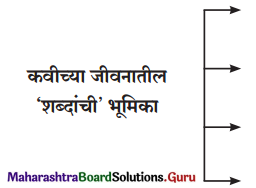
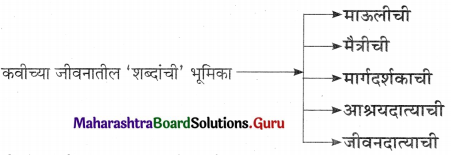
![]()
![]()
![]()
![]()
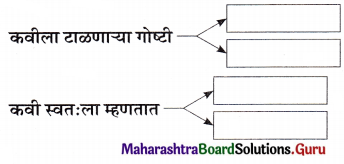

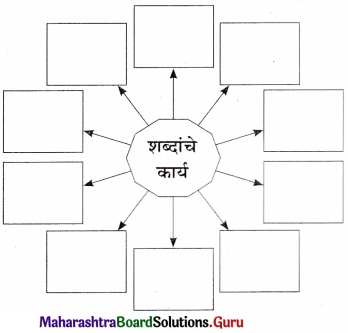
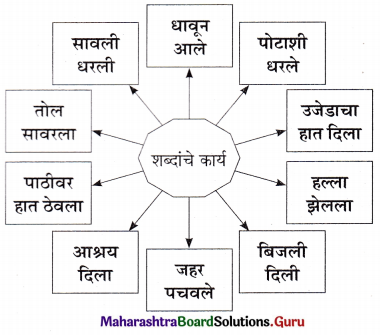
![]()
![]()













